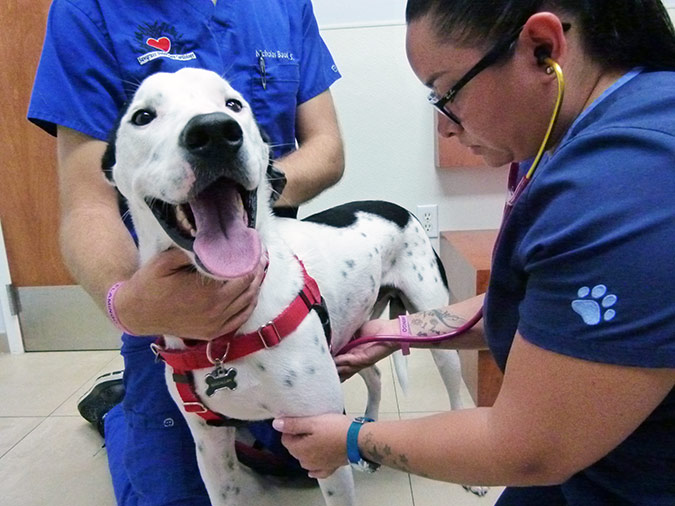The Duty of Ultrasound and CT Check in Modern Veterinary Practices: Insights From Experienced Professionals
In modern vet practices, ultrasound and CT scans greatly enhance analysis abilities. These imaging techniques offer crucial insights right into animal health and wellness, guiding treatment decisions. Experienced experts acknowledge the one-of-a-kind benefits of each modality. Ultrasound supplies real-time analyses, while CT scans supply elaborate physiological details. Recognizing their roles and applications elevates vital concerns concerning their effect on individual end results and the future of vet diagnostics. What insights can be gotten from their integrated usage?
Recognizing Ultrasound in Vet Medicine
Ultrasound is a crucial diagnostic tool in vet medication, providing a non-invasive technique to visualize inner structures. This imaging method employs high-frequency acoustic waves to produce real-time pictures of cells and body organs, permitting vets to analyze conditions without surgical intervention. Usual applications include examining the heart, liver, kidneys, and reproductive body organs, in addition to keeping an eye on pregnancies.The procedure is reasonably quick and can be performed in numerous setups, making it an accessible option for vets. Unlike radiography, ultrasound provides thorough info about soft cells and blood flow, which is crucial for accurate diagnoses.Veterinary specialists rely upon ultrasound to identify irregularities such as lumps, cysts, and fluid accumulation. Its capability to assist biopsies and other treatments additionally improves its utility in scientific method. By offering a efficient and risk-free means to take a look at internal makeup, ultrasound has actually become a cornerstone of contemporary veterinary diagnostics.
The Advantages of CT Scans for Pet Diagnostics
CT scans deal considerable benefits in veterinary diagnostics by supplying enhanced accuracy in identifying internal problems (CT Scans For Dogs). As a non-invasive imaging method, they assure the security and convenience of animals during examinations. On top of that, CT scans help with a comprehensive analysis of internal frameworks, enabling extra effective treatment preparation
Boosted Analysis Accuracy
Advancements in imaging technology have actually greatly enhanced analysis accuracy in veterinary medication, especially via making use of CT scans. These scans give thorough cross-sectional photos of a pet's interior frameworks, permitting veterinarians to determine irregularities with accuracy. The high resolution and three-dimensional capacities of CT imaging assist in the detection of problems such as growths, cracks, and inner blood loss that could be missed out on with traditional imaging approaches. Additionally, CT scans can aid in pre-surgical planning by providing a complete view of physiological partnerships. This level of detail not just enhances the precision of diagnoses yet also help in tailoring efficient treatment strategies. The integration of CT modern technology into veterinary practices is changing the landscape of pet healthcare, boosting end results for clients.
Non-Invasive Imaging Method
The intro of non-invasive imaging strategies has transformed pet diagnostics, with CT checks becoming a famous device in vet practices. These scans give high-resolution, cross-sectional photos of an animal's inner frameworks, allowing veterinarians to analyze complicated conditions without the demand for invasive treatments. The advantages of CT scans include their capability to detect lumps, fractures, and interior bleeding with impressive precision. Additionally, they assist in the evaluation of soft cells and organs, boosting analysis capabilities. The rate of CT scanning allows fast decision-making, which is essential in emergency situation circumstances. By reducing stress and anxiety and discomfort for the animal, CT scans add to a more humane method to diagnostics, inevitably enhancing treatment end results and advancing veterinary treatment.
Comprehensive Internal Evaluation
A complete interior analysis is crucial for accurate diagnosis and efficient treatment in vet medication. CT scans offer considerable benefits hereof, supplying in-depth cross-sectional photos of an animal's inner frameworks. This sophisticated imaging method improves visualization of intricate anatomical areas, enabling vets to determine irregularities such as lumps, fractures, and inner bleeding with greater precision. Additionally, CT checks assist in the analysis of conditions that may be challenging to detect through typical methods. The speed and accuracy of CT imaging also contribute to timely treatments, improving patient outcomes. As veterinary techniques increasingly integrate CT modern technology, the advantages of considerable internal evaluations become noticeable, reinforcing the importance of this tool in modern veterinary diagnostics.
Comparing Ultrasound and CT Imaging Techniques
While both ultrasound and CT imaging serve essential roles in vet diagnostics, each method supplies unique benefits and restrictions that can influence scientific decision-making. Ultrasound is particularly valued for its real-time imaging capacities, permitting vets to observe vibrant physical processes. This method is non-invasive, mobile, and does not involve ionizing radiation, making it a safer choice for both animals and clinicians. Ultrasound might have limitations in picturing certain anatomical structures or deep tissues.Conversely, CT imaging provides detailed cross-sectional views of the body, allowing for specific localization of irregularities. It excels in reviewing complex organs and structures, especially in the thorax and abdominal area. Nonetheless, CT scans require sedation or anesthesia in most cases and entail direct exposure to ionizing radiation. Ultimately, the option between ultrasound and CT depends on the specific professional situation, the area of interest, and the seriousness of the analysis demands.
Situation Researches: Effective Diagnoses Through Imaging
Study highlight the significant improvements in analysis precision attained via advanced imaging technologies like ultrasound and CT scans in vet practices. These innovations not only improve the discovery of various conditions however additionally facilitate reliable and prompt therapy strategies. Analyzing particular instances can highlight the transformative influence of these imaging strategies on vet medicine.
Analysis Accuracy Improvements

Imaging Modern Technology Advancements
As vet imaging innovation remains to progress, its influence on diagnostic capabilities becomes significantly obvious. Recent study highlight the effective application of sophisticated ultrasound and CT scan techniques in identifying intricate conditions. A vet clinic made use of high-resolution CT scans to diagnose an unusual form of lung cancer in a canine, which traditional imaging had missed out on. In a similar way, an ultrasound examination disclosed an abdominal mass in a pet cat, triggering timely medical intervention and a favorable outcome. These advancements not just enhance diagnostic accuracy but additionally enable veterinarians to design targeted therapy plans. By leveraging advanced imaging modern technologies, vet specialists are considerably boosting client care, resulting in a lot more efficient administration of different health and wellness problems in animals.
The Duty of Imaging in Emergency Situation Vet Treatment
Imaging plays a vital duty in emergency situation veterinary care, supplying veterinarians with essential information needed to make rapid, enlightened decisions. In urgent circumstances, techniques like ultrasound and CT scans enable professionals to swiftly evaluate a pet dog's internal structures, determining essential problems such as internal blood loss, cracks, or organ problems. These imaging techniques permit real-time examinations, facilitating timely interventions that can be life-saving. For instance, ultrasound is invaluable for assessing soft cells injuries and problems like fluid accumulation, while CT scans deal in-depth photos of complicated anatomical frameworks, vital for detecting injury cases. The rate and precision of these imaging strategies enhance the vet's ability to design efficient therapy strategies, ensuring the ideal possible end results for their people. As a result, the integration of sophisticated imaging innovations right into emergency situation veterinary techniques is not just helpful yet significantly required, as it enhances diagnostic abilities and boosts overall animal treatment throughout vital minutes.
Training and Knowledge in Vet Imaging
Innovative imaging techniques such as ultrasound and CT scans are crucial for effective vet treatment, the successful implementation of these modern technologies greatly depends on the training and know-how of veterinary specialists. Competent use imaging tools needs thorough knowledge of makeup, pathology, and the principles underlying each technique. Vet specialists must undergo customized training to accurately translate imaging results, which is essential for diagnosing problems and preparing treatment.Certifications and proceeding education in veterinary imaging boost the abilities of professionals, enabling them to remain upgraded with technological advancements. Collaboration between vets and radiologists often causes boosted diagnostic accuracy, as specialists can supply understandings right into complex cases. Furthermore, sensible experience in dealing with imaging tools promotes confidence in its application. Eventually, the top quality of veterinary imaging services is directly correlated to the level of training and expertise had by the specialists using these important analysis devices.
Future Fads in Diagnostic Imaging for Animals
With the fast innovations in innovation, vet analysis imaging is poised for significant advancement in the coming years. Arising fads indicate a change towards even more easily accessible and mobile imaging techniques, such as portable ultrasound devices, which might enhance field diagnostics. Additionally, the assimilation of expert system is anticipated to transform photo analysis, enabling quicker and much more exact analyses of results.Moreover, developments in 3D imaging techniques and computed tomography will certainly provide veterinarians with more complete views of animal makeup, bring about enhanced therapy strategies. Digital truth technology might also contribute in surgical preparation and education, giving veterinarians a special point of view on complex cases.As telemedicine remains to grow, remote web link consultations assisted in by diagnostic imaging will end up being a lot more typical, permitting professionals to assist family doctors in real-time. Generally, these fads are readied to improve the efficiency and performance of vet care, inevitably improving pet results.
Frequently Asked Inquiries
Just How Much Do Ultrasound and CT Scans Expense in Veterinary Centers?
The prices of ultrasound and CT scans in vet clinics typically range from $300 to $1,500, depending upon variables such as location, center kind, and particular treatments needed for the pet's diagnosis and treatment.

Exist Any Kind Of Dangers Associated With Ultrasound and CT Scans for Family Pets?
Ultrasound and CT scans normally position very little dangers to family pets. Nevertheless, potential worries consist of sedation responses and direct exposure to anesthetics. Board Certified Veterinary Cardiologist. Veterinarians thoroughly evaluate each instance to alleviate any risks connected with these analysis treatments
How Long Do Ultrasound and CT Treatments Usually Take?
Ultrasound procedures generally take about 30 minutes to an hour, depending upon the intricacy. CT scans, being more thorough, usually call for 30 mins to 90 mins, consisting of prep work and recovery time for the animal.
Can All Veterinarians Perform Ultrasounds and CT Scans?
Not all vets can execute ultrasounds and CT scans. Specialized training and qualification are commonly required to ensure expertise in these advanced imaging strategies, which might limit their schedule to vets with extra certifications and resources.
What Kinds Of Animals Benefit Most From These Imaging Techniques?
Certain pet species, particularly that site pet dogs and cats, benefit considerably from ultrasound and CT scans. These imaging techniques enhance analysis accuracy for problems like lumps, inner injuries, and organ abnormalities, bring about better therapy outcomes and individual care. The high resolution and three-dimensional abilities of CT imaging assist in the detection of problems such as lumps, fractures, and interior blood loss that may be missed with standard imaging approaches. Instance researches show the substantial enhancements in diagnostic precision accomplished via sophisticated imaging innovations like ultrasound and CT scans in vet techniques. Improving diagnostic precision in veterinary practices has been substantially assisted by advancements in imaging innovations such as ultrasound and CT scans. Advanced imaging methods such as ultrasound and CT scans are necessary for effective veterinary treatment, the effective execution of these innovations heavily depends on the training and know-how of veterinary specialists. Veterinary experts must undertake specific training to accurately interpret imaging results, which is crucial for diagnosing problems and preparing treatment.Certifications and continuing education in veterinary imaging improve the skills of experts, enabling them to stay upgraded with technical developments.